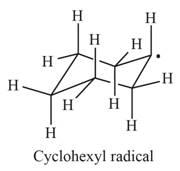
Concept explainers
Draw the products of homolysis or heterolysis of each indicated bond. Use electronegativity
differences to decide on the location of charges in the heterolysis reaction. Classify each
carbon reactive intermediate as a radical, carbocation, or carbanion.
a. b.
b. 
(a)
Interpretation: The products of homolysis or heterolysis of the indicated bond is to be drawn by using the electronegativity differences. Each carbon reactive intermediate is to be classified as a radical, carbocation, or carbanion.
Concept introduction: In organic chemistry, the formation of carbocation or carbanion occurs due to the heterolysis or homolysis process. Carbocations possess six electrons around them, whereas carbanions possess the lone pair of electrons. Carbocation behaves as electrophile due to lack of electrons and incomplete octet.
Answer to Problem 26P
In the given indicated bond, homolysis takes place that results in the formation of the radicals.
The first product is,

The second product is,

Explanation of Solution
The heterolysis does not take place in the given compound due to the less electronegativity difference between atoms.
The product of homolysis is shown below.

Figure 1
In the above reaction, cyclohexane forms cyclohexyl radical and hydrogen radical by homolysis. Homolysis is opposite to the heterolysis. It forms radical with unpaired electron because the electrons are not attracted toward one element in the homolysis.
In the given indicated bond, homolysis takes place that results in the formation of the radical. The product of homolysis is shown in Figure 1.
(b)
Interpretation: The products of homolysis or heterolysis of the indicated bond is to be drawn by using the electronegativity differences. Each carbon reactive intermediate is to be classified as a radical, carbocation, or carbanion.
Concept introduction: In organic chemistry, the formation of carbocation or carbanion occurs due to the heterolysis or homolysis process. Carbocations possess six electrons around them, whereas carbanions possess the lone pair of electrons. Carbocation behaves as electrophile due to lack of electrons and incomplete octet.
Carbanion behaves as a nucleophile in the chemical reaction due to the presence of excess electrons. Heterolysis is the process in which unequal sharing of electrons results in the breaking of the bond.
Answer to Problem 26P
In the given indicated bond, heterolysis takes place that results in the formation of the carbocation.
The first product is,

The second product is,

Explanation of Solution
Heterolysis in the compound takes place due to the more electronegativity difference. The product of heterolysis is shown below.

Figure 2
In the above reaction, ethanol forms ethyl carbocation and hydroxide ion by heterolysis. The heterolysis in the chemical reaction leads to the formation of ionic species because electrons are attracted toward more electronegative atom. Oxygen is more electronegative than carbon. Therefore, heterolysis and the formation of carbocation take place in the reaction.
In the given indicated bond, heterolysis takes place that results in the formation of the carbocation. The product of heterolysis is shown in Figure 2.
Want to see more full solutions like this?
Chapter 6 Solutions
Package: Loose Leaf For Organic Chemistry With Connect Access Card (1 Semester)
- Using the Functional Group and Reagent to Identity the Type of Reaction Draw the product of each reaction.arrow_forwardDraw the reaction and choose the correct characterizationsarrow_forwardRefer to the reaction energy diagram to answer parts (a) through (e). (a) The rate-limiting step is: ______. (b) The transition state for the fastest step is: _____. (c) In the third step which intermediate structurally resembles the transition state according to the Hammond postulate? _____. (d) Which step no. is endergonic? _____. (e) The number of intermediates in the overall reaction is: _____.arrow_forward
- Provide an appropriate alkyne starting material A and intermediate product B. Omit byproducts. The number of carbon atoms in the starting material should be the same as in the final product.arrow_forwardreaction by filling in any Starting materials, reagents or products as needed.arrow_forwardFinish the indicated reaction by filling in and starting materials, reagents or products as needed arrow_forward
 Organic ChemistryChemistryISBN:9781305580350Author:William H. Brown, Brent L. Iverson, Eric Anslyn, Christopher S. FootePublisher:Cengage Learning
Organic ChemistryChemistryISBN:9781305580350Author:William H. Brown, Brent L. Iverson, Eric Anslyn, Christopher S. FootePublisher:Cengage Learning Organic Chemistry: A Guided InquiryChemistryISBN:9780618974122Author:Andrei StraumanisPublisher:Cengage Learning
Organic Chemistry: A Guided InquiryChemistryISBN:9780618974122Author:Andrei StraumanisPublisher:Cengage Learning

